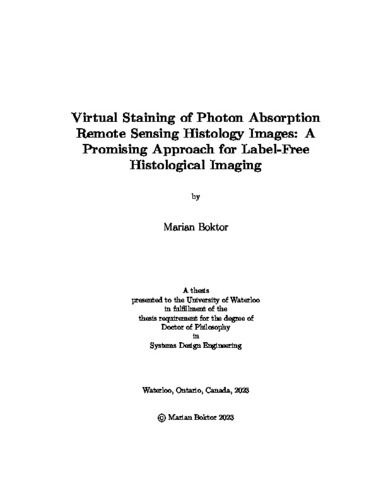| dc.description.abstract | Histology is a crucial diagnostic tool in medicine and biological research, providing
valuable insights into tissue morphology and cellular structures. However, conventional
histological staining methods are time-consuming. In recent years, label-free microscopy
such as photon absorption remote sensing (PARS) has emerged as a promising alternative.
PARS microscope utilizes the optical absorption properties of target absorbers to
capture high-resolution images of tissues at various wavelengths. This thesis focuses on
the development of virtual staining pipelines for PARS histology images.
First, a hematoxylin and eosin (H&E) virtual staining pipeline is introduced utilizing
state-of-the-art image-to-image translation models, namely pix2pix and cycleGAN. The
pipeline consists of preprocessing, image registration, model training, and model testing
stages. The trained models facilitate the translation of PARS images into stained versions,
replicating the appearance of H&E-stained histology images. The results demonstrate a
strong concordance between virtually stained images and true H&E, with pathologists
reviewing the results of one of the studies and confirming that the diagnostic quality of
the virtually stained PARS images closely resemble that of gold standard H&E.
While PARS has made substantial progress in virtual staining, certain challenges persist,
particularly regarding model confusion between tissue structures, which results in colorization
ambiguity. To enhance structure distinction, we propose expanding the number
of input channels in the virtual staining models. This involves introducing a multi-channel
virtual staining pipeline that includes feature extraction from PARS time-resolved signals
using an existing modified K-means algorithm and a proposed feature selection method
based on metrics like the Structural Similarity Index (SSIM). This pipeline aims to enhance
the virtual staining process through feature labeling prior to model training. The
results show that optimized feature combinations outperform conventional PARS channels
in virtually staining human skin and mouse brain tissue, yielding a significant visual and
quantitative agreement with gold-standard H&E images.
Finally, the proposed virtual staining frameworks are modified to accommodate a
broader range of stains and tissue types. In order to showcase the versatility of the frameworks,
we apply them to datasets containing Periodic Acid-Schiff (PAS) stain in addition
to H&E, specifically using a human fungus tissue sample. The experimental results show
that incorporating additional features outperforms conventional PARS channels in both
H&E and PAS stains, suggesting the potential of this approach to enhance tissue structure
labeling and improve different staining techniques. Moreover, this approach demonstrates
the feasibility of using PARS to generate different virtual stains from the same data sources.
Throughout the thesis, extensive experimentation and evaluation are conducted using
diverse PARS datasets and ground truth histology images. Performance metrics, such
as accuracy and visual fidelity, in addition to clinical validation, are employed to assess
the effectiveness of the virtual staining pipelines. The findings presented in this thesis
demonstrate the efficacy and versatility of the proposed approaches, contributing to the
advancement of slide-free histological imaging, which promises to dramatically reduce the
time from specimen resection to histological imaging. | en |

